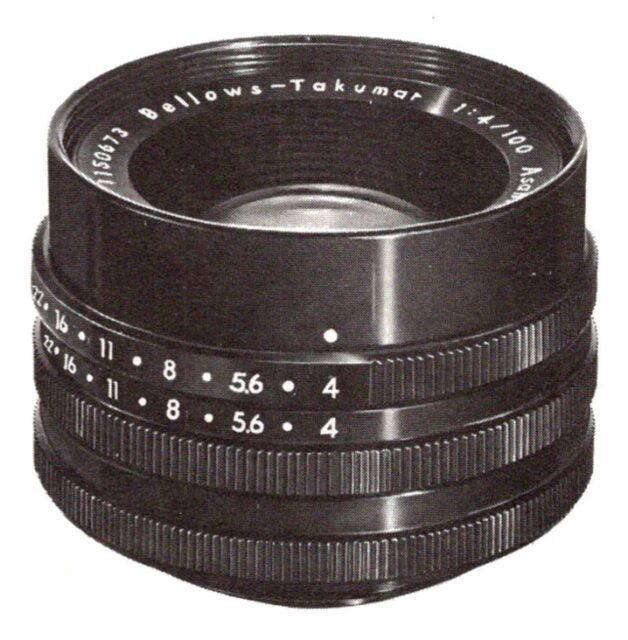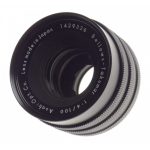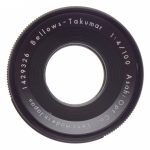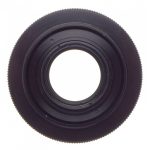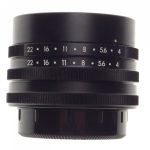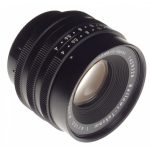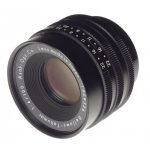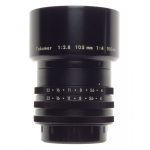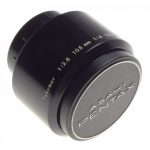Announced
Production status
Original name
System
Downloads
Genres or subjects of photography
Recommended slowest shutter speed when shooting static subjects handheld
Asahi Bellows-Takumar 100mm F/4
Macro lens • Film era • Discontinued
Model history
| ■Asahi Bellows-Takumar 100mm F/4 [360, 43600] | P | 5 - 3 | ⌀49 | 1964 ● | ||
| ■Asahi Super-Multi-Coated Bellows-Takumar 100mm F/4 [43601] | P | 5 - 3 | ⌀49 | 1971 ● | ||
Specification


| Optical design: | |
| 100mm | |
| F/4 | |
| 35mm full frame | |
| M42 [45.5mm] (Bellows) | |
| 24.4° (35mm full frame) | |
| 5 elements in 3 groups | |
| Diaphragm mechanism: | |
Diaphragm type: | Preset |
Aperture control: | Preset ring + Aperture ring |
| 8 (eight) | |
| Focusing: | |
Focusing modes: | Manual focus only |
Manual focus control: | None; focusing with bellows |
| Physical characteristics: | |
| 142g | |
| ⌀55.5×36.6mm | |
| Accessories: | |
| Screw-type 49mm | |
| Screw-type round | |
| Not available |
Sources of data
- The Ultimate Asahi Pentax Screw Mount Guide 1952-1977 book by Gerjan van Oosten (1999).
- Lenses for the Honeywell Pentax booklet (October, 1965).
- Asahi Pentax Takumar interchangeable lenses operating manual (PUB. 06081).
- Asahi Pentax Takumar interchangeable lenses operating manual (red cover).
- Complete system of photography: Asahi Pentax lenses and accessories booklet (PUB. 63008).
- Honeywell Photographic Products booklet (March 1969).
- Honeywell Pentax cameras, lenses, and accessories booklet (March 1971).
- Honeywell Photographic GSA Catalog and Price List (December 1, 1970 through November 30, 1971).
- Asahi Pentax Spotmatic II operating manual (PUB. 06461, early).
- Asahi Pentax SV & S1a operating manual (PUB. 61008, 18 pages).
- Honeywell Pentax H3v/H1a operating manual.
- Honeywell Pentax SL operating manual (August 1969).
- Honeywell Pentax SP 500 operating manual.
- Honeywell Pentax Spotmatic II operating manual.
- Honeywell Pentax Spotmatic operating manual (May 1967).
- Honeywell Pentax Spotmatic operating manual.
- Asahi Pentax Lenses & Accessories - Complete System of Photography (PUB. 06106).
Manufacturer description #1
This really versatile lens combines all the qualities of a macro lens with the efficiency of a long-focus optic. Since you can expand or contract the Bellows freely, you can focus continually from infinity to magnified close-up. This is the ideal lens for precision shots requiring long focusing and for photographing live animals from a distance.
Features
This is a long focal length macro lens to be used together with the Bellows or Auto-Bellows Unit.
Emphasis has been placed on precision at the expense of brightness: distortion has been reduced to practically nil and the same fine results are obtained at all distances down to magnified close-ups. Combined with the Bellows Unit, photography from infinity down to life-size close-ups is possible, while with the Auto-Bellows magnification of up to 1.32 is possible. Thus you can take distant scenics and superb close-ups with one and the same lens. The 100mm focal length makes this lens ideal for studies of insects, small animals and other subjects which are difficult to approach and also for close-ups under difficult lighting conditions : the required magnification is obtained without having to bring the lens close in. This lens also has fine perspective characteristics.
Main uses
Ideally suited to studies of insects, the natural perspective qualities of this lens also make it a fine choice for all close-ups taken from some distance from the subject.
Manufacturer description #2
Specifically designed for use in conjunction with the focusing bellows unit this short mount 100mm f4 lens constitutes an impressive specialist Tele-Macro lens, focusing from life size to infinity. The superior high resolution performance is due to the fact that again this lens is computed for close-up and macrophotography.
Furthermore, the lens will still provide critical definition and resolution for all normal subjects. The fact that one can work with a comfortable lens/subject distance relationship when photographing insects or small animals and the like is particularly valuable when a closer approach is not possible or desirable for whatever reason. Further, it eases the sometimes difficult problem of establishing adequate frontal lighting.
Distortion is virtually non-existent. The diaphragm is pre-set with a 'click' stop indent control ring and the lens accepts standard 49mm filters.
Principal Uses
Ranging from specialist Macro studies, but including a wide range of general purpose applications with all the advantages offered by this unusual lens.
Manufacturer description #3
This 100mm lens is designed for use on a bellows, but it allows you to photograph from infinity to as close as 6 inches from a subject. With it you can take pictures of distant mountain scenes or greater than life-size negatives of stamps or coins with equal ease and clarity. It is, therefore, a new and valuable tool for both amateur and professional photographers.
The Bellows-Takumar is particularly suited for use with the Pentax Bellows II on the Spotmatic camera, which will automatically compensate for the exposure factors involved in extreme close-up work. The focal length of the lens not only provides ample image size and convenient working distances for tightly cropped photographs of small objects, but also makes it ideal for portraits. The photographer who owns the Bellows-Takumar lens will find himself putting it to a range of uses he never thought possible.
Min. focus 6 inches from lens rim when used on Pentax Bellows II.
Asahi TAKUMAR series
The first generation of lenses designed for Asahi Pentax 35mm SLR cameras with the M42 screw mount. Introduced with the Asahi Pentax in 1957.
- Robust, all-metal design with aperture ring(s) and depth-of-field scale in chrome finish (up to 135mm telephotos);
- Preset or manual diaphragm;
- Extremely accurate manual focusing with knurled focusing ring (400mm+ super telephotos have finely-ribbed focusing rings);
- Single-layer anti-reflection coating.
Other macro lenses in the Asahi Pentax M42 system
Sorted by focal length and speed, in ascending order
| ■M42 mount (5) | |||||||||
| Asahi Macro-Takumar 50mm F/4 [367, 43670] • 1:1 | P | 4 - 3 | 0.21m | ⌀49 | 1964 ● | ||||
| Asahi Super-Macro-Takumar 50mm F/4 [391, 43910, 43911] • 1:2 | A | 4 - 3 | 0.23m | ⌀49 | 1966 ● | ||||
| Asahi Super-Multi-Coated Macro-Takumar 50mm F/4 [43912] • 1:2 | A | 4 - 3 | 0.23m | ⌀49 | 1971 ● | ||||
| Asahi Super-Multi-Coated Bellows-Takumar 100mm F/4 [43601] | P | 5 - 3 | ⌀49 | 1971 ● | |||||
| Asahi Super-Multi-Coated Macro-Takumar 100mm F/4 [43922] • 1:2 | A | 5 - 3 | 0.45m | ⌀49 | 1972 ● | ||||
Lenses with similar focal length
Sorted by manufacturer name
| ■M42 mount (7) | |||||||||
| Cosina 100mm F/3.5 MC Macro • 1:2 aka Phoenix 100mm F/3.5 Macro aka Promaster Spectrum 7 100mm F/3.5 MC Macro aka Soligor 100mm F/3.5 MC Macro aka Vivitar 100mm F/3.5 MC Macro | A | 5 - 4 | 0.43m | ⌀49 | ● | ||||
| Panagor 90mm F/2.8 Auto Macro PMC • 1:1 | A | 6 - 4 | 0.35m | ⌀62 | ● | ||||
| Sigma MF 90mm F/2.8 Multi-Coated Macro ZEN • 1:2 | A | 9 - 9 | 0.32m | ⌀52 | 1988 ● | ||||
| Soligor C/D 100mm F/2.8 Macro P (s/n 1xxxxxxx) • 1:2 | A | 6 - 4 | 0.42m | ⌀62 | 1974 ● | ||||
| Tokina AT-X 90mm F/2.5 Macro • 1:2 | A | 8 - 7 | 0.39m | ⌀55 | 1983 ● | ||||
| Vivitar Series 1 90mm F/2.5 VMC Macro (s/n 37xxxxxx) • 1:2 | A | 8 - 7 | 0.39m | ⌀58 | 1975 ● | ||||
| Vivitar 90mm F/2.8 Auto Macro (s/n 28xxxxxx) • 1:1 | A | 6 - 4 | 0.35m | ⌀62 | 1976 ● | ||||
| ■Interchangeable mount (5) | |||||||||
| Heinz Kilfitt Munchen Makro-Kilar 90mm F/2.8 aka Zoomar Muenchen Macro-Kilar 90mm F/2.8 aka Zoomar Muenchen Macro-Zoomatar 90mm F/2.8 | P | 4 - 3 | -- | 1956 ● | |||||
| Sigma[-XQ] MF 100mm F/2.8 Multi-Coated Macro [YS] • 1:1 | A | 7 - 5 | 0.33m | ⌀62 | 1972 ● | ||||
| Tamron SP 90mm F/2.5 Macro 52B [Adaptall-2] • 1:2 | A | 8 - 6 | 0.39m | ⌀49 | 1979 ● | ||||
| Tamron SP 90mm F/2.5 Macro 52BB [Adaptall-2] • 1:2 | A | 8 - 6 | 0.39m | ⌀55 | 1984 ● | ||||
| Tamron SP 90mm F/2.8 Macro 72B [Adaptall-2] • 1:1 | A | 10 - 9 | 0.29m | ⌀55 | 1996 ● | ||||
